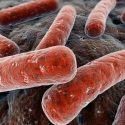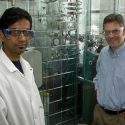Study: Prions likely more mobile in alkaline soils
Prions, the rogue proteins that cause chronic wasting disease and similar maladies, may be more mobile in soil that is more alkaline, suggests a new study by University of Wisconsin–Madison researchers.
That finding has implications for the safe disposal of carcasses of animals infected with chronic wasting disease, “mad cow” disease, scrapie and other prion diseases. Prions from those carcasses can remain infectious in the soil for at least three years. Soil alkalinity varies considerably but can be relatively high in older landfills, especially if lime is spread on the carcasses to speed decomposition.
The study is reported in the April 15 issue of the journal Environmental Science and Technology.
The UW–Madison research team found that as alkalinity increases, prions are less likely to adhere to particles of quartz, a common soil mineral, and are therefore expected to be more mobile, explains Joel Pedersen, an assistant professor of soil science.
Movement of prions in the soil could be a good or bad thing, depending on the situation, Pedersen explains. For example, if they move away from the surface, they’re less likely to be ingested by animals.
“Those that remain near the surface would more accessible to animals and might therefore lead to the spread of chronic wasting,” he points out.
On the other hand, prions that are more mobile might be more likely to migrate through a landfill, he adds.
“In a landfill, if prions are mobile, they could be transported down through the waste, where they could enter the landfill’s leachate collection system, and from there be directed to wastewater treatment plants. If prions survive wastewater treatment, they would be released back into the environment in treated water or in the sludge,” Pedersen says.
However, Pedersen cautions that his findings are from a highly simplified experimental system, and that any assessments about the safety of landfilling carcasses would have to be based on studies of how prions behave in municipal solid waste and the soils used in landfills. The research team is now undertaking such studies.
He also says that the findings don’t necessarily mean that it’s a bad idea to bury carcasses with lime.
“The lime treatment could destroy some prions,” he says. “We don’t know yet. It’s only the prions that might survive that might be more mobile.”
The experiment that generated these findings involved mixing a solution that included prions and pure quartz sand, letting it stand for a specific period of time and then measuring how many prions remained free in the solution. In a real-world setting the prions would in be a mix of landfill materials, not just quartz, and the soil solution would be percolating downward.
For the next set of experiments, the researchers are flowing water through columns of materials like those found in carcass disposal sites, including both soil and solid waste, Pedersen explains.
Other members of the research team include Xin Ma, a postdoctoral researcher in the UW–Madison’s Department of Soil Science; Craig Bensen in the Department of Civil and Environmental Engineering; and Judd Aiken and Debbie McKenzie in the Department of Comparative Biosciences.



